A New Peak-Shaving Model Based on Mixed Integer Linear Programming with Variable Peak-Shaving Order
Abstract
1. Introduction
2. Model
2.1. Model Formulation
2.1.1. Objective Function
- Minimize the power output variation:where N and T are the number of plants and periods, respectively; and are the output increase and decrease in MW of plant i from period t-1 to period t, respectively. In other words, this objective aims to minimize the output fluctuation between two adjacent time steps;
- Minimize the distance to the working capacity:where represents the distance of the scheduled output to the expected working capacity in MW of plant i in time period t.
2.1.2. Operational Constraints
- The power generation target, which requires for the total produced energy to meet the electric quantity determined by operators or trade clearance, expressed as:where denotes the length of one time step in hours. is the power output in MW of plant i in time period t. is the target or transactional energy in MWh of power plant i;
- The power balance, requiring for the total power output of all plants to match the system load in any time interval t, which is expressed as:where is the load demand in MW in period t;
- The distance to the working capacity, which, corresponding to Equation (2), is expressed as:where is the expected working capacity in MW of power plant i, and is the theoretical upper bound on power output in MW of plant i;
- The feasible operating zones for a plant to generate in the lower and upper bounds in each time step, expressed as:where and denote the upper and lower bounds of power output in MW in operating zone j of plant i respectively, and is the number of operating zones of power plant i;
- The trend of power output, making plants share the peak-shaving pressure, expressed as:where period τ represents every possible time periods when system load in t is bigger than that in τ. By sorting the values of system load, the sets of τ with respect to any time period t can be found out. This constraint ensures the power output of each plant not to enlarge the peak-valley differences.
2.2. Model Reformulation
2.2.1. Operation Constraints Reformulation
- The energy target during the scheduling horizon:where and are positive and negative deviations from the target energy production in MWh of plant i, respectively, of which only one can and will be greater than zero;
- Hourly load balance:
- The power output ramping:
- The working capacity. As shown in Equation (5), the constraint should be satisfied for all time periods which is actually not necessary or possible in some cases and can be simplified. When there is at least one unit online, indicating the power output is greater than zero, the output should meet the working capacity constraint. By introducing a binary variable, the constraint can be reconstructed as below:where is a binary variable representing the operating state of hydro plant i in period t, which is equal to 1 when the plant is online and 0 otherwise. M is a sufficiently large number relative to system load and can be assigned to twice the peak load;
- The operating zones:where represents whether power plant i runs in operating zone j in period t, and Equation (16) means one operating zone at most is workable at any given time for any plant committed;
- The power output constraints across different periods:where in MW indicates that the output of plant i in t plus can be greater than the output in τ. is the accumulative value of over different τ. In other words, represents a kind of violation over the constraint that the trend of power output of each plant should be consistent with the system load and hereafter will be only referred to as Trend Violation Item (TVI). Figure 1 demonstrates the meaning of TVI while the time periods on horizontal axis has been sorted in ascending order for system load values.
- Non-negative constraint, enforced on all the variables to be nonnegative.
2.2.2. Objective Function Reformulation
2.3. Applicability of the Model
3. Model Solving Method
4. Case Studies
4.1. Engineering Background
4.2. Parameter Setting
4.3. Results and Discussions
5. Conclusions
- The achievement of the peak-shaving task in an optimization way, showing strength of simplicity in principle and significance in solution efficiency over the traditional peak-shaving method which needs to set the peak-shaving order for each plant;
- A simplified method presented for determining the plant-based operating zones, and the introduction of power output consistency with the trend of system load as constraints that are expressed mathematically;
- The case studies in the Lancang hydropower cascade, suggesting that the model itself has good flexibility, and with further enrichment and expansion, can also be applied to power systems with power plants that can regulate their hourly generations within a day.
Author Contributions
Funding
Acknowledgments
Conflicts of Interest
References
- Feng, Z.-K.; Niu, W.-J.; Cheng, C.-T.; Zhou, J. Peak shaving operation of hydro-thermal-nuclear plants serving multiple power grids by linear programming. Energy 2017, 135, 210–219. [Google Scholar] [CrossRef]
- Wu, Y. Discussion on key factors for efficient consumption of renewable energy in provincial power grid at southern China. CSEE J. Power Energy Syst. 2020, 6, 554–562. [Google Scholar] [CrossRef]
- Wang, X.; Chang, J.; Meng, X.; Wang, Y. Short-term hydro-thermal-wind-photovoltaic complementary operation of interconnected power systems. Appl. Energy 2018, 229, 945–962. [Google Scholar] [CrossRef]
- Secretariat, R.; Programme, U.E. Renewables 2020 Global Status Report; REN21 Secretariat: Paris, France, 2021; p. 367. [Google Scholar]
- Feng, Z.-K.; Niu, W.-J.; Wang, W.-C.; Zhou, J.-Z.; Cheng, C.-T. A mixed integer linear programming model for unit commitment of thermal plants with peak shaving operation aspect in regional power grid lack of flexible hydropower energy. Energy 2019, 175, 618–629. [Google Scholar] [CrossRef]
- Xie, M.; Zhou, J.; Li, C.; Lu, P. Daily generation scheduling of cascade hydro plants considering peak shaving constraints. J. Water Resour. Plan. Manag. 2016, 142, 11. [Google Scholar] [CrossRef]
- Shen, J.; Cheng, C.-T.; Wang, S.; Yuan, X.; Sun, L.; Zhang, J. Multiobjective optimal operations for an interprovincial hydropower system considering peak-shaving demands. Renew. Sustain. Energy Rev. 2020, 120, 17. [Google Scholar] [CrossRef]
- Gaudard, L.; Romerio-Giudici, F. The future of hydropower in Europe: Interconnecting climate, markets and policies. Environ. Sci. Policy 2014, 37, 172–181. [Google Scholar] [CrossRef]
- Graabak, I.; Korpås, M.; Jaehnert, S.; Belsnes, M. Balancing future variable wind and solar power production in Central-West Europe with Norwegian hydropower. Energy 2019, 168, 870–882. [Google Scholar] [CrossRef]
- Simopoulos, D.N.; Kavatza, S.D.; Vournas, C.D. An enhanced peak shaving method for short term hydrothermal scheduling. Energy Convers. Manag. 2007, 48, 3018–3024. [Google Scholar] [CrossRef]
- Wu, R.N.; Lee, T.H.; Hill, E.F. An investigation of the accuracy and the characteristics of the peak-shaving method applied to production cost calculations. IEEE Trans. Power Syst. 1989, 4, 1043–1049. [Google Scholar] [CrossRef]
- Wang, J.; Zhang, Y. Short-term optimal operation of hydropower reservoirs with unit commitment and navigation. J. Water Resour. Plan. Manag. 2012, 138, 3–12. [Google Scholar] [CrossRef]
- Wu, X.; Cheng, C.-T.; Shen, J.-J.; Luo, B.; Liao, S.; Li, G. A multi-objective short term hydropower scheduling model for peak shaving. Int. J. Electr. Power Energy Syst. 2015, 68, 278–293. [Google Scholar] [CrossRef]
- Wang, J.; Liu, S.; Zhang, Y. Quarter-hourly operation of large-scale hydropower reservoir systems with prioritized constraints. J. Water Resour. Plan. Manag. 2015, 141, 13. [Google Scholar] [CrossRef]
- Chang, G.W.; Tsai, Y.D.; Lai, C.Y.; Chung, J.S. A practical mixed integer linear programming based approach for unit commitment. In Proceedings of the IEEE Power Engineering Society General Meeting, Denver, CO, USA, 6–10 June 2004; Volume 221, pp. 221–225. [Google Scholar]
- Tong, B.; Zhai, Q.; Guan, X. An MILP based formulation for short-term hydro generation scheduling with analysis of the linearization effects on solution feasibility. IEEE Trans. Power Syst. 2013, 28, 3588–3599. [Google Scholar] [CrossRef]
- Ma, T.; Wang, J.; Liu, Y.; Sun, H.; Gui, D.; Xue, J. A mixed integer linear programming method for optimizing layout of irrigated pumping well in oasis. Water 2019, 11, 1185. [Google Scholar] [CrossRef]
- Liu, S.; Xie, M. Modeling the daily generation schedules in under-developed electricity markets with high-share renewables: A case study of Yunnan in China. Energy 2020, 201, 117677. [Google Scholar] [CrossRef]
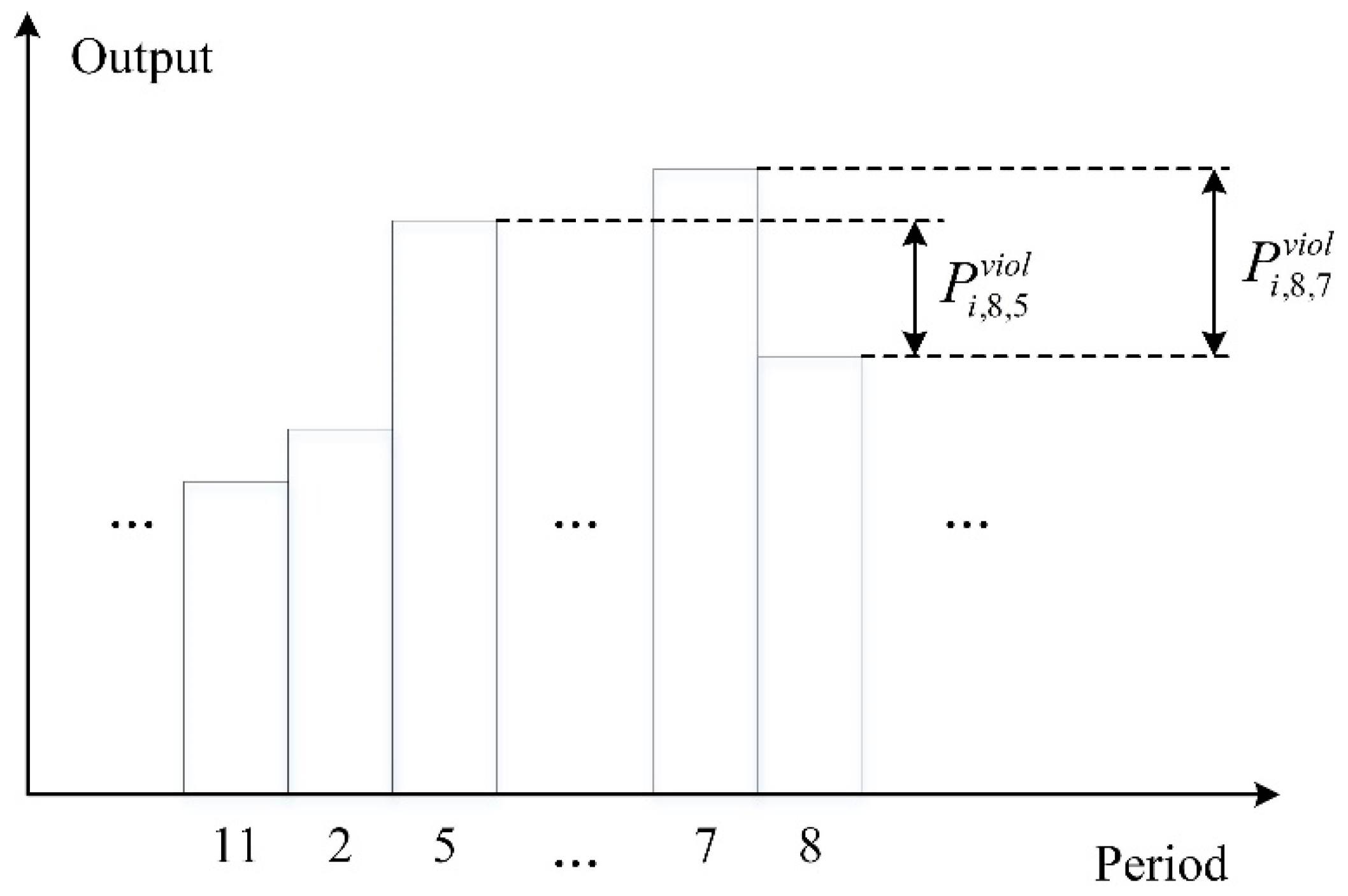
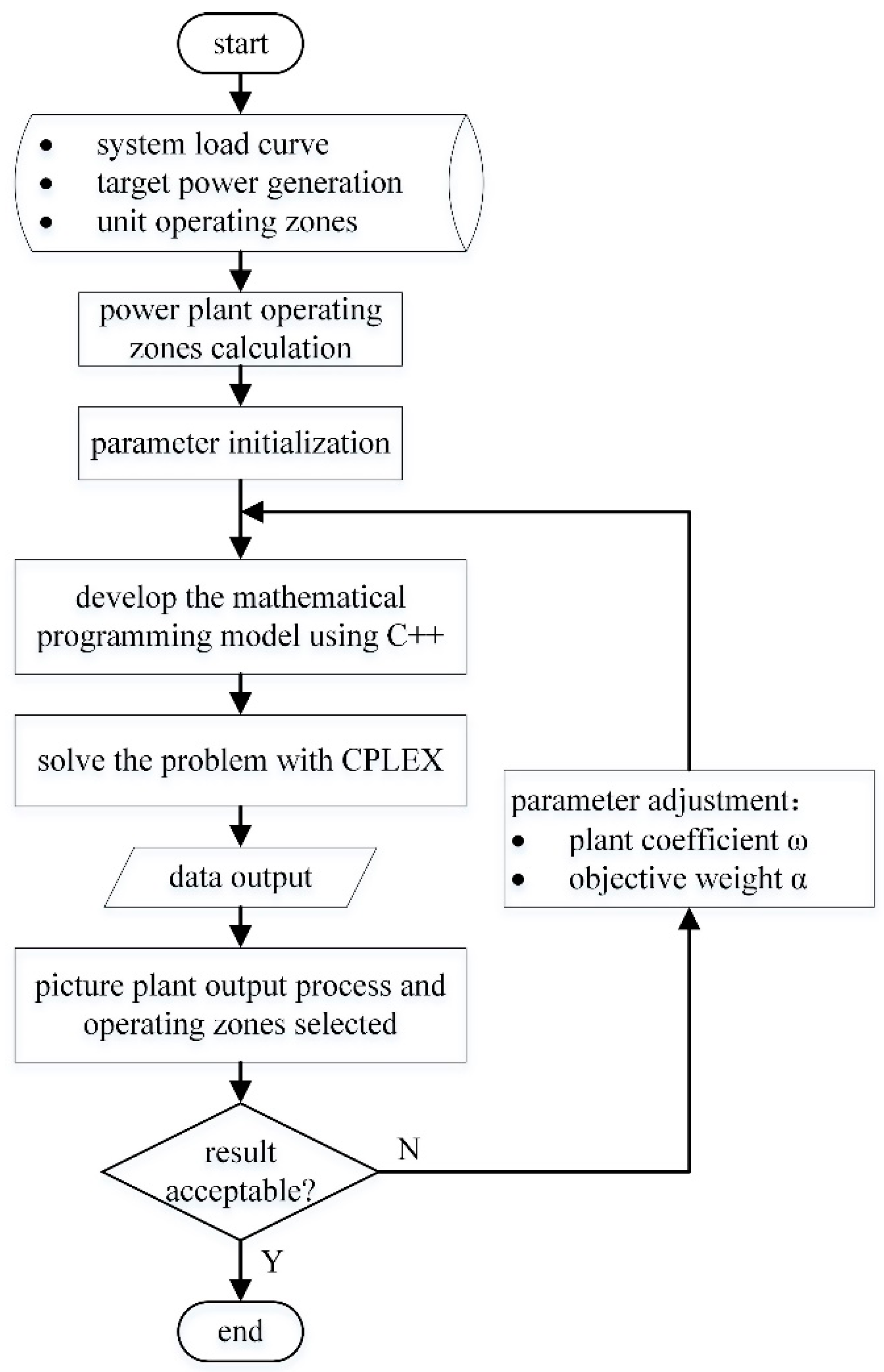

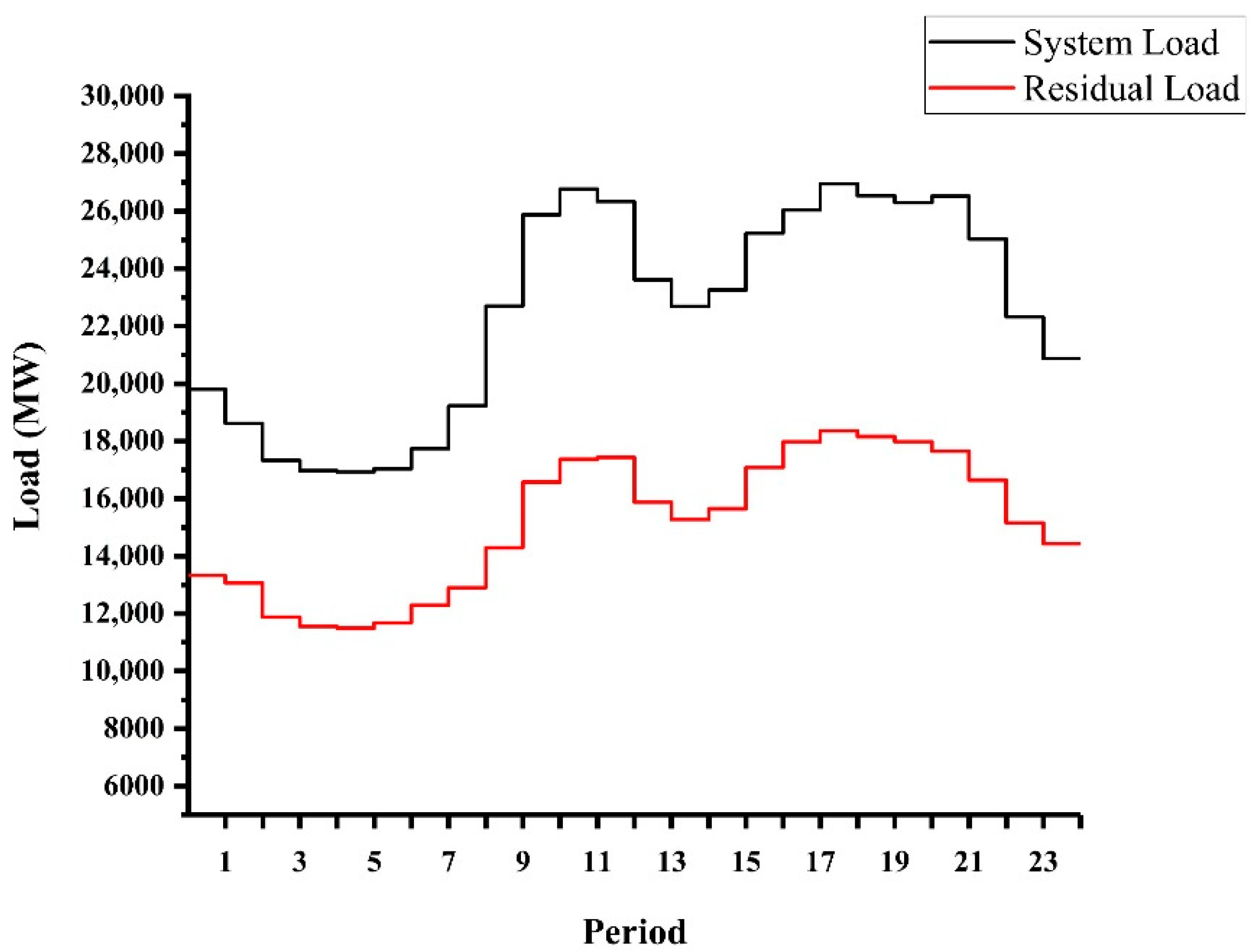
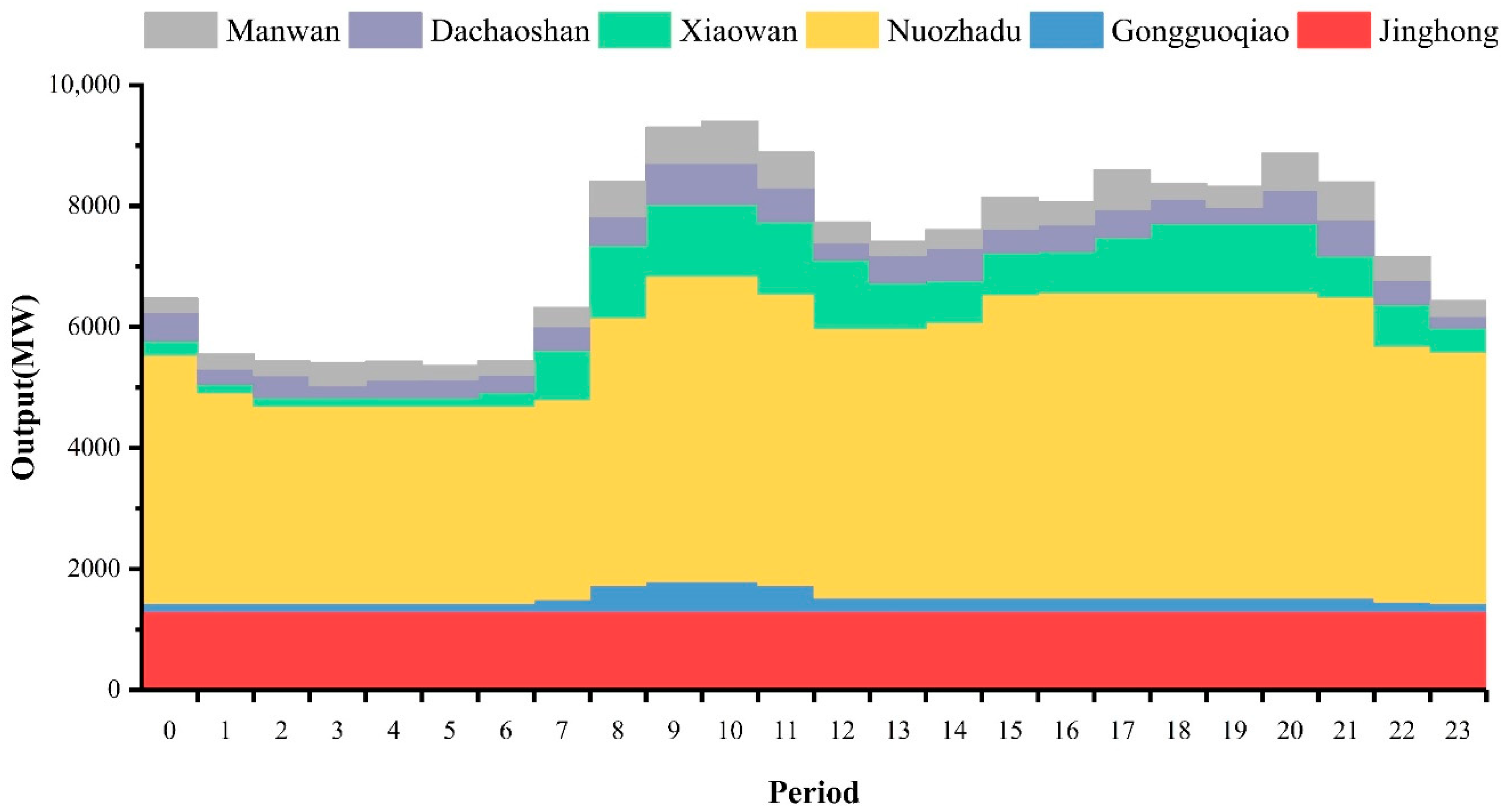
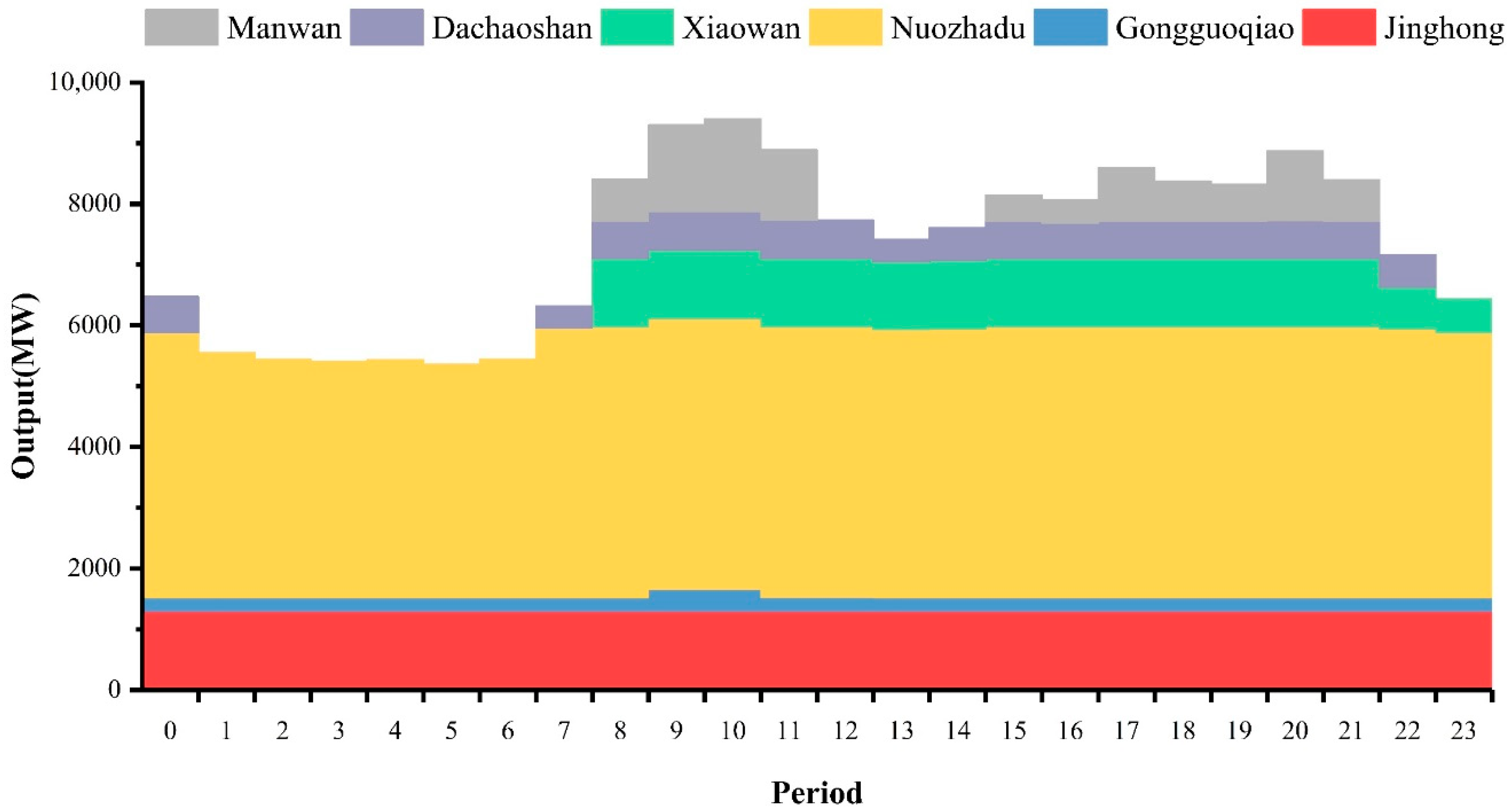
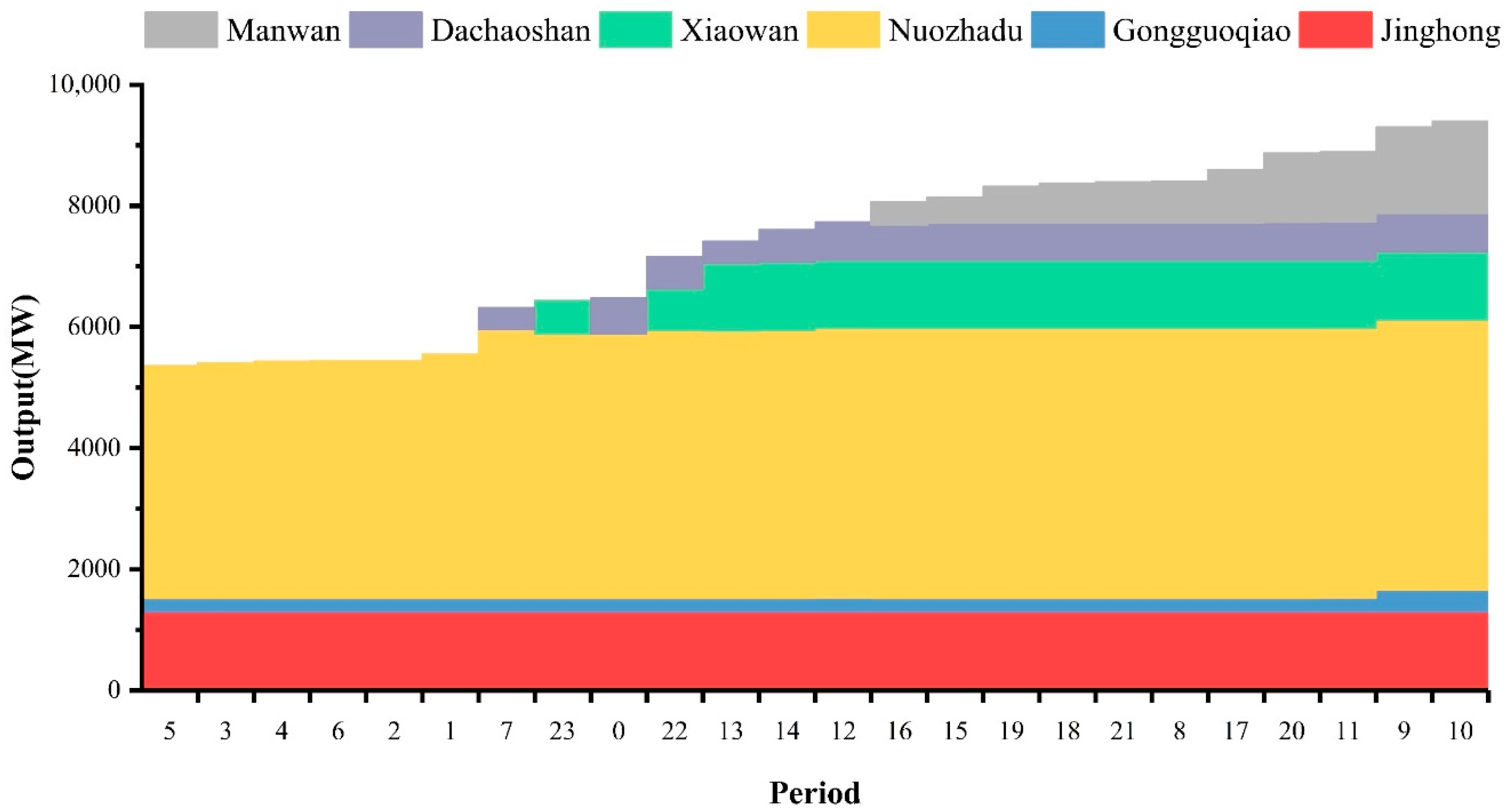


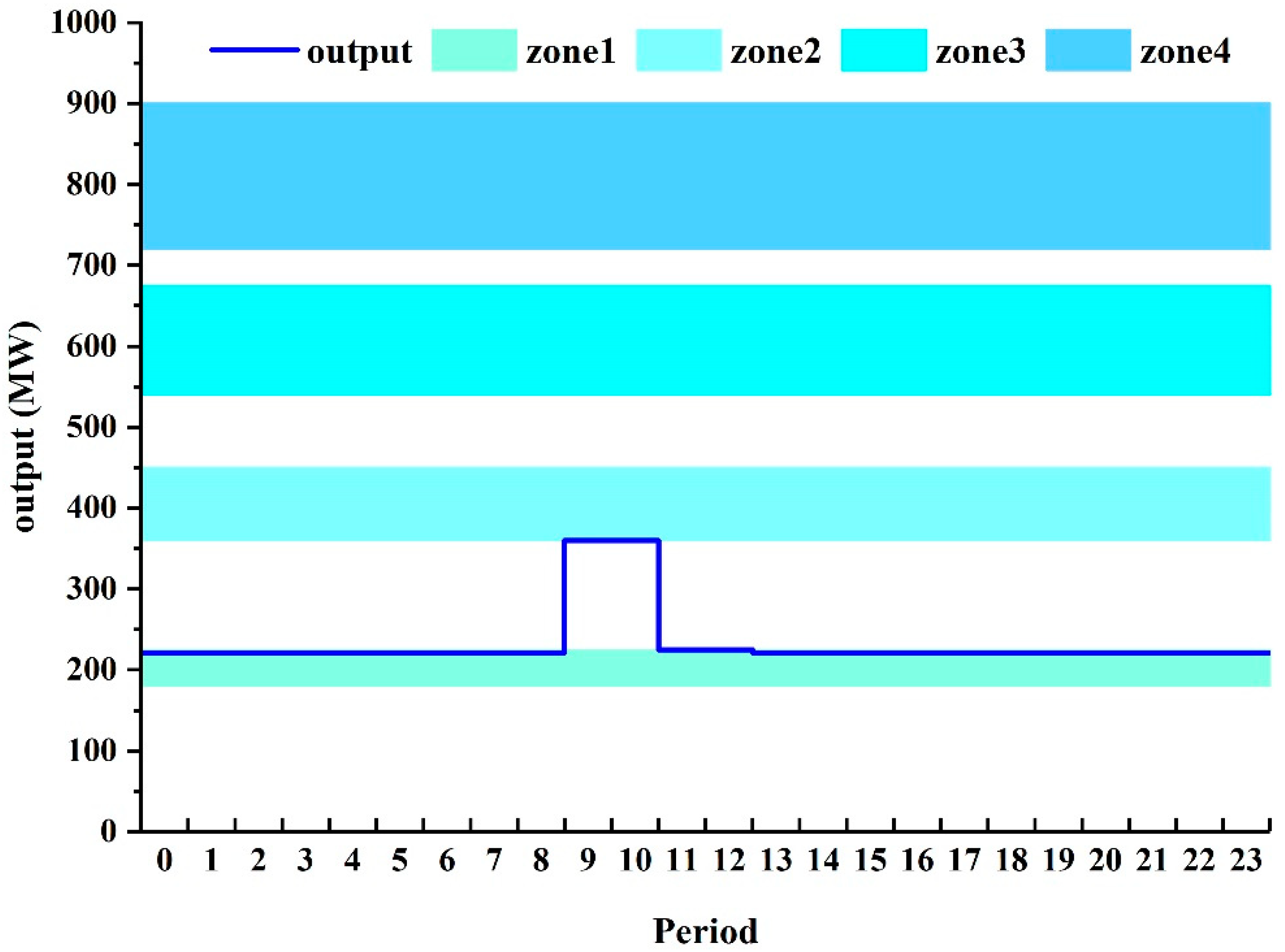
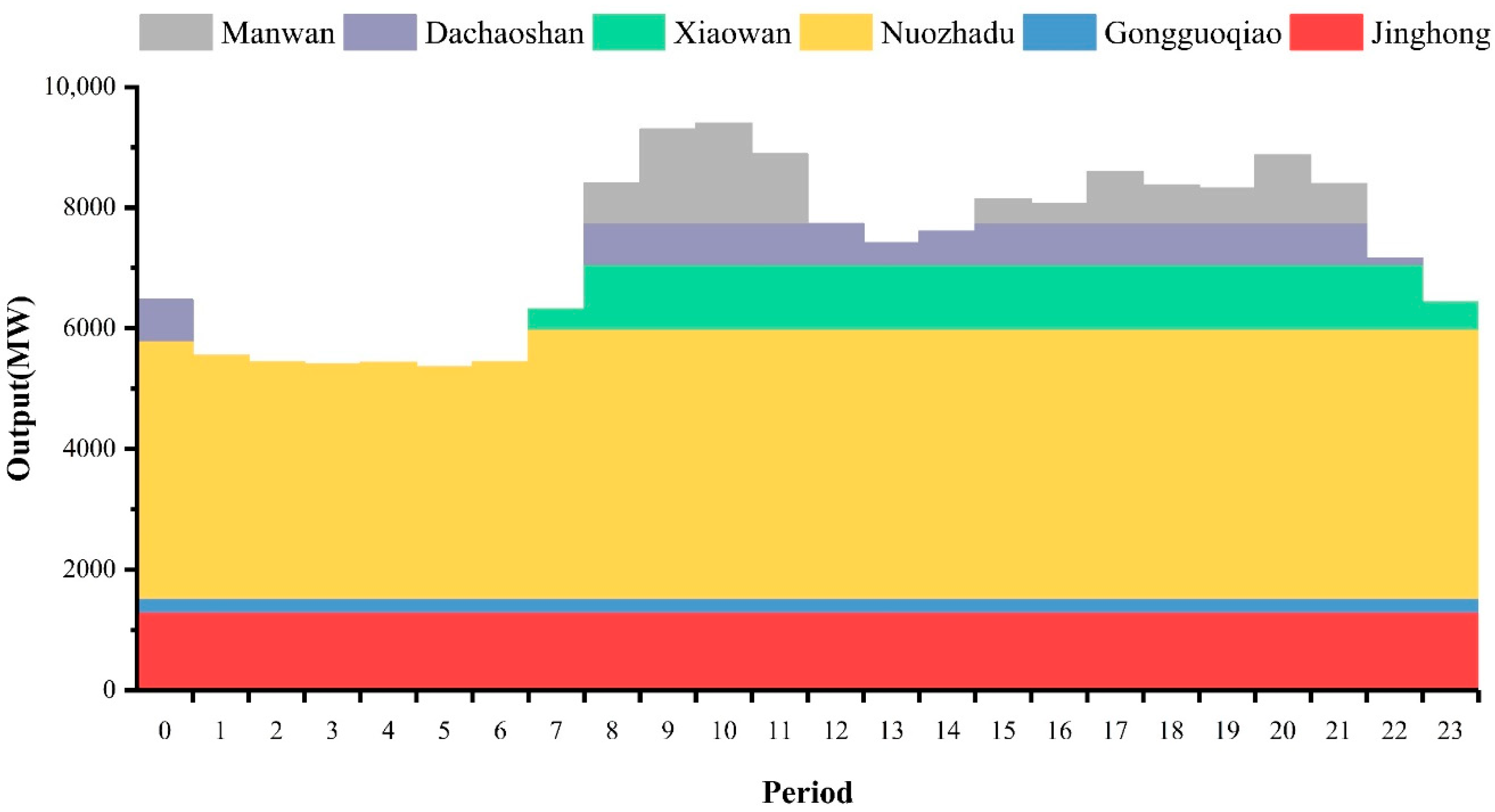
| Plant Name | Unit Number | Installed Capacity (MW) | Regulation Performance |
|---|---|---|---|
| Gongguoqiao | 4 | 900 | daily |
| Xiaowan | 6 | 4200 | multi-year |
| Manwan | 7 | 1670 | seasonal |
| Dachaoshan | 6 | 1350 | seasonal |
| Nuozhadu | 9 | 5850 | multi-year |
| Jinghong | 5 | 1750 | weekly |
| Coefficient | Value |
|---|---|
| 100 | |
| 10 | |
| 1 | |
| 1 |
| Hour | Gongguoqiao | Xiaowan | Manwan | Dachaoshan | Nuozhadu | Jinghong |
|---|---|---|---|---|---|---|
| 0 | 221 | 0 | 0 | 598 | 4358 | 1300 |
| 1 | 221 | 0 | 0 | 0 | 4035 | 1300 |
| 2 | 221 | 0 | 0 | 0 | 3922 | 1300 |
| 3 | 221 | 0 | 0 | 0 | 3887 | 1300 |
| 4 | 221 | 0 | 0 | 0 | 3911 | 1300 |
| 5 | 221 | 0 | 0 | 0 | 3838 | 1300 |
| 6 | 221 | 0 | 0 | 0 | 3922 | 1300 |
| 7 | 221 | 0 | 0 | 360 | 4441 | 1300 |
| 8 | 221 | 1124 | 683 | 617 | 4459 | 1300 |
| 9 | 360 | 1124 | 1426 | 630 | 4459 | 1300 |
| 10 | 360 | 1124 | 1531 | 630 | 4459 | 1300 |
| 11 | 225 | 1124 | 1151 | 630 | 4459 | 1300 |
| 12 | 225 | 1124 | 0 | 630 | 4459 | 1300 |
| 13 | 221 | 1120 | 0 | 360 | 4414 | 1300 |
| 14 | 221 | 1120 | 0 | 540 | 4430 | 1300 |
| 15 | 221 | 1124 | 424 | 617 | 4459 | 1300 |
| 16 | 221 | 1124 | 384 | 579 | 4459 | 1300 |
| 17 | 221 | 1124 | 876 | 617 | 4459 | 1300 |
| 18 | 221 | 1124 | 651 | 617 | 4459 | 1300 |
| 19 | 221 | 1124 | 603 | 617 | 4459 | 1300 |
| 20 | 221 | 1124 | 1151 | 623 | 4459 | 1300 |
| 21 | 221 | 1124 | 671 | 617 | 4459 | 1300 |
| 22 | 221 | 677 | 0 | 540 | 4430 | 1300 |
| 23 | 221 | 560 | 0 | 0 | 4358 | 1300 |
| Plant | Load | Historical | Optimized |
|---|---|---|---|
| Gongguoqiao | - | 30.30 | 12.05 |
| Xiaowan | - | 124.02 | 73.77 |
| Manwan | - | 134.62 | 260.39 |
| Dachaosahn | - | 121.93 | 106.98 |
| Nuozhadu | - | 204.78 | 60.05 |
| Jinghong | - | 0 | 0 |
| Cascade | 513.25 | 616.66 | 513.25 |
Publisher’s Note: MDPI stays neutral with regard to jurisdictional claims in published maps and institutional affiliations. |
© 2021 by the authors. Licensee MDPI, Basel, Switzerland. This article is an open access article distributed under the terms and conditions of the Creative Commons Attribution (CC BY) license (http://creativecommons.org/licenses/by/4.0/).
Share and Cite
Cheng, X.; Feng, S.; Huang, Y.; Wang, J. A New Peak-Shaving Model Based on Mixed Integer Linear Programming with Variable Peak-Shaving Order. Energies 2021, 14, 887. https://doi.org/10.3390/en14040887
Cheng X, Feng S, Huang Y, Wang J. A New Peak-Shaving Model Based on Mixed Integer Linear Programming with Variable Peak-Shaving Order. Energies. 2021; 14(4):887. https://doi.org/10.3390/en14040887
Chicago/Turabian StyleCheng, Xianliang, Suzhen Feng, Yanxuan Huang, and Jinwen Wang. 2021. "A New Peak-Shaving Model Based on Mixed Integer Linear Programming with Variable Peak-Shaving Order" Energies 14, no. 4: 887. https://doi.org/10.3390/en14040887
APA StyleCheng, X., Feng, S., Huang, Y., & Wang, J. (2021). A New Peak-Shaving Model Based on Mixed Integer Linear Programming with Variable Peak-Shaving Order. Energies, 14(4), 887. https://doi.org/10.3390/en14040887





